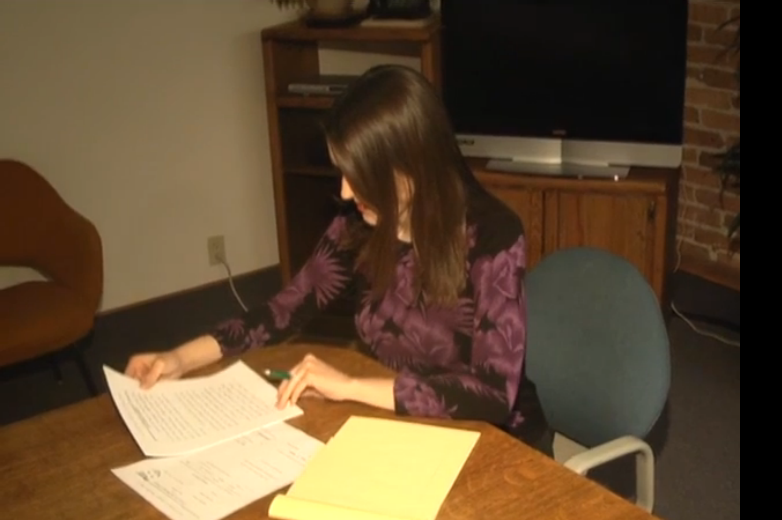One morning. I stayed off Twitter for a one morning, and this is what happens?
Hilarious selfie video RT @LaurenNBCMT Did some court doc reading and note-taking (as you see in the video) on the plan that Kevin Briggs…
— Ted Sullivan (@TedJSullivan) February 11, 2014
The Chronicle’s Assistant Managing Editor Ted Sullivan tweeted his amusement and frustration at NBC Montana’s Lauren Maschmedt for her falling prey to that TV news stable: B-roll that shows the reporter herself doing something mundane.
It snowballed a bit from there.
TV reporters: don’t show footage of you looking through court docs. As a view, I don’t want to see you do the most mundane part of your job.
— Whitney Bermes (@wabermes) February 11, 2014
@wabermes but how else do they show you they’ve “dug deeper” ??
— Beth Saboe (@BethSaboe) February 11, 2014
@BethSaboe @wabermes @TedJSullivan I got 99 problems but reading court docs ain’t 1.
— Erin Schattauer (@ErinSchattauer) February 11, 2014
@ErinSchattauer @BethSaboe @wabermes Two rules: Always take selfie video. Always make story about yourself, not the story.
— Ted Sullivan (@TedJSullivan) February 11, 2014
@TedJSullivan @ErinSchattauer @wabermes Dang, I knew I forgot something! Unnecessary, embarrassing selfie video of me breaking that story!
— Beth Saboe (@BethSaboe) February 11, 2014
@BethSaboe @TedJSullivan @ErinSchattauer Well, when you’re the last news outlet to report it, you have to find some way to spice things up!
— Whitney Bermes (@wabermes) February 11, 2014
Maschmedt eventually responded with sarcasm and veiled charges of bullying.
@TedJSullivan I love how the newspaper shamelessly makes fun of TV. One of the SPJ pillars, I’m sure!
— Lauren Maschmedt NBC (@LaurenNBCMT) February 11, 2014
Bullying might be too strong a word, but there is definite mockery there. It’s certainly not fun to be the brunt of a Twitter conversation questioning the job that you’ve done — especially when one of the people joining in is a fellow TV newser.
And, admittedly, some of the non-Maschmedt tweets are a bit cavalier and maybe unprofessional. I’ll chalk that attitude up to a passion to see the job of journalism done well, no matter who is doing it.
Yet the criticism of NBC Montana’s story is deserved.
The story in question is about the FBI filing charges against Bozeman escapee Kevin A. Briggs. Maschmedt’s voiceover carries us through all the facts, but the video accompanying it shows us close-ups of the federal documents too close up for us to really read anything in them, shots of Maschmedt sitting at a table in a darkened room reading those documents, a close-up of her hand taking notes on a legal pad, on her eyes scanning the lines of text.
Shots of a reporter “digging deeper” into documents have no place in a news story. They aren’t telling the public anything important. Instead, those valuable airtime seconds are marketing the reporter and the news station.
“See? See? Look how much work we are doing to inform you, viewers. The work is so important, watch some of it being reenacted while my voiceover tells you what I found.”
I do see. I see you doing your job, plain and simple. But the work of journalism isn’t news; the results are news. And those results are what we need to be giving viewers and readers, not self-aggrandizing B-roll.
A parallel is to be found in a recent post from journalism professor and blogger Jeff Jarvis, who is somewhere in the middle of a series on rethinking TV news. Jarvis’ post targets the stand-up (where a reporter simply stands in front of the camera at some location and says things into the camera).
The stand-up has zero journalistic value. It wastes time. It wastes precious reportorial resource. It turns the world into a mere backdrop for entertainment. It’s a fake.
The B-roll shots of the reporter walking in to a public building or flipping through file drawers are just as big wastes of time.
Sometimes we get stuck in the form of news and forget that the first mission is to deliver the facts. TV reporters have to fill airtime, and they are taught to fill it with something other than them just sitting there reading the news. It’s a convention — just like the one that we face at the newspaper when we have to have one story with “main art” on the section front pages — even if that means covering less-than-impactful feature stories.
But to keep our work relevant, we have to remember that conventions are not set in stone, and that if there’s a better way to tell people the news efficiently, we should take advantage of it. Our audiences will appreciate it.
And snarky journalists won’t make fun of you for it.
